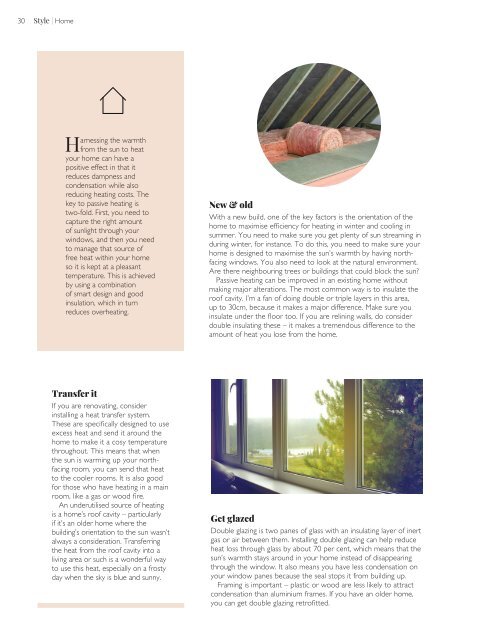Style: June 04, 2021
Create successful ePaper yourself
Turn your PDF publications into a flip-book with our unique Google optimized e-Paper software.
30 <strong>Style</strong> | Home<br />
H<br />
arnessing the warmth<br />
from the sun to heat<br />
your home can have a<br />
positive effect in that it<br />
reduces dampness and<br />
condensation while also<br />
reducing heating costs. The<br />
key to passive heating is<br />
two-fold. First, you need to<br />
capture the right amount<br />
of sunlight through your<br />
windows, and then you need<br />
to manage that source of<br />
free heat within your home<br />
so it is kept at a pleasant<br />
temperature. This is achieved<br />
by using a combination<br />
of smart design and good<br />
insulation, which in turn<br />
reduces overheating.<br />
New & old<br />
With a new build, one of the key factors is the orientation of the<br />
home to maximise efficiency for heating in winter and cooling in<br />
summer. You need to make sure you get plenty of sun streaming in<br />
during winter, for instance. To do this, you need to make sure your<br />
home is designed to maximise the sun’s warmth by having northfacing<br />
windows. You also need to look at the natural environment.<br />
Are there neighbouring trees or buildings that could block the sun?<br />
Passive heating can be improved in an existing home without<br />
making major alterations. The most common way is to insulate the<br />
roof cavity. I’m a fan of doing double or triple layers in this area,<br />
up to 30cm, because it makes a major difference. Make sure you<br />
insulate under the floor too. If you are relining walls, do consider<br />
double insulating these – it makes a tremendous difference to the<br />
amount of heat you lose from the home.<br />
Transfer it<br />
If you are renovating, consider<br />
installing a heat transfer system.<br />
These are specifically designed to use<br />
excess heat and send it around the<br />
home to make it a cosy temperature<br />
throughout. This means that when<br />
the sun is warming up your northfacing<br />
room, you can send that heat<br />
to the cooler rooms. It is also good<br />
for those who have heating in a main<br />
room, like a gas or wood fire.<br />
An underutilised source of heating<br />
is a home’s roof cavity – particularly<br />
if it’s an older home where the<br />
building’s orientation to the sun wasn’t<br />
always a consideration. Transferring<br />
the heat from the roof cavity into a<br />
living area or such is a wonderful way<br />
to use this heat, especially on a frosty<br />
day when the sky is blue and sunny.<br />
Get glazed<br />
Double glazing is two panes of glass with an insulating layer of inert<br />
gas or air between them. Installing double glazing can help reduce<br />
heat loss through glass by about 70 per cent, which means that the<br />
sun’s warmth stays around in your home instead of disappearing<br />
through the window. It also means you have less condensation on<br />
your window panes because the seal stops it from building up.<br />
Framing is important – plastic or wood are less likely to attract<br />
condensation than aluminium frames. If you have an older home,<br />
you can get double glazing retrofitted.


















